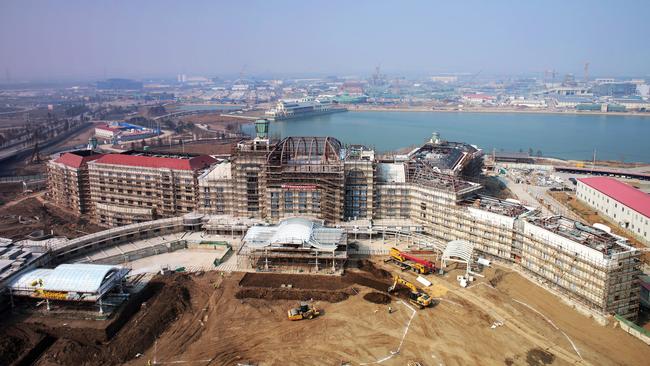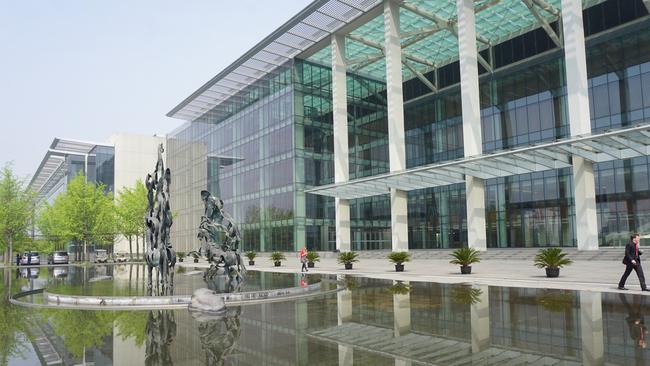Tomorrowland now: Shanghai’s Disneyland Park showcases new tech
The Disneyland Park opening in Shanghai is not just for the kids: it ushers in a whole new world of technology.

East will meet West when the first Disneyland Park in mainland China opens on June 16 in Shanghai. It’s a massive construction: three times that of Hong Kong Disneyland, with a big castle at its centre. There are six themed lands, an entertainment district, hotels and a lake, with further construction down the track.
Shanghai Disney Resort is a huge undertaking owned 43 per cent by Disney and 57 per cent by Shanghai government companies, and is another indicator of the confidence China exudes to the world despite its slowing economic growth.
The new Disneyland Park also will be home to communications technology that will have an impact on the world. At its global briefing to journalists in Shenzhen last week, China telco supplier Huawei detailed how it would revolutionise the use of cellular phone networks across the globe.
It’s important news for Australia as Huawei supplies equipment to Optus and Vodafone, and built 4G networks for both.
Huawei is an important company to watch, for one thing because of its enormous spending on research and development. While we were debating the Abbott government’s cutting of about $450 million from our science agencies, Huawei was in the midst of a $47 billion, 10-year spend on R&D. Last year it increased R&D spending to 15.1 per cent of revenue, about $11.8bn. That puts it in the category of Intel, Microsoft, Google and Amazon.
Further, it operates 16 R&D centres globally and holds more than 50,000 patents. So when Huawei Australia chairman John Lord says Australia’s new communications technology will be imported, he’s on firm ground.
One new technology is 4.5G, an interim standard promoted by Huawei between 4G and 5G due in 2020. It streams data at enormous gigabit speeds and can address modern needs such as 2K and 4K video streaming, cloud computing through mobile, and the streaming of virtual reality and augmented reality to headsets.
Streaming virtual reality from far away to a headset near you was part of the dream Facebook’s Mark Zuckerberg articulated at a memorable speech in Barcelona in February. “It’s going to change the way we live and work and communicate,” he said.

Huawei, China Unicom and Shundu (Disney’s agent) have reached an agreement to introduce 4.5G to the Disney resort. Plans include monitoring the flow of people around the resort and smart parking, which Huawei intends to bring to the market next year.
Shanghai Disneyland will boast the largest Disney castle in the world. Disney says the resort will showcase the best of its storytelling while celebrating China’s heritage. Major construction is complete and the resort has hired almost 2000 cast members and staff for its design and development arm.
Last year Huawei, in partnership with China Unicom, trialled parking sensors placed in the road to detect a car’s movement in and out of a designated space. Not only can approaching drivers be notified of a free space, drivers moving out of spaces in future could be billed through an app.
There is a shift towards the billions of sensors known collectively as internet of things connecting via mobile networks rather than primarily through a router and wired broadband network. Gigabit fixed-wire broadband is part of the IoT plan too.
But wireless IoT is a ubiquitous solution that can be rolled out in any country with mobile networks, independently of hardwired internet. Connecting the IoT directly to mobile is a big deal for Huawei internationally, as it is for Telstra locally.
It is estimated there will be more than 14 billion network-enabled devices on the internet by 2020 — about two for every person on the planet. So internet connections will be predominantly machine connections rather than human ones.
Go out further, and Huawei is looking at 100-150 billion connections by 2025.
The future is not just your smartphone connected to the mobile network. Everything will be connected to the mobile network: power, water and gas meters, security alarms and motion detectors, vehicles in mining operations, rubbish bins, smart street lights, and shipping container trackers.
Devices that measure the nutritional quality of cattle feed will upload data directly to mobile networks. This application particularly interests Huawei in Australia. Its partner, Vodafone, announced in December last year an agreement with the National Farmers Federation to implement sensors that measure soil moisture, monitor water levels and deliver live updates from the field.
In the cities, smart rubbish bins will report when they are full and the collection route of rubbish trucks can vary accordingly. Smart street lights not only will adjust to lighting conditions, as they can now, they will adjust to measurements of traffic flow and the presence of people on the street.

Rented bicycles, health and wellbeing monitors, tracking devices for children and the elderly, connected home airconditioners and climate control systems will communicate with the internet through the mobile network.
Huawei says it has already implemented 4.5G in Denmark and Hong Kong and has conducted testing in Australia. At a trial at Newcastle in February, Huawei and Optus achieved a download speed of 1.41Gbps.
Apart from faster 4.5G connections, there is a communications technology underpinning the coming rollout of sensors connecting to the internet. It’s known as narrowband IoT, or NB-IoT. Telstra has been pursuing it through its partnership with Ericsson, and last week Huawei revealed its NB-IoT blueprint.
At its briefing to analysts, Huawei said NB-IoT would cope with up to 100,000 connected devices per cell. It offered stronger security than Wi-Fi, is cheap to implement at an estimated $US5 ($6.40) a device, and has incredibly low power communications.
Batteries in sensors that connect periodically to report their data can last 10 years. Depending on usage, you can bury a sensor in the ground and in theory not have to dig it up for a decade. Being low frequency also offers better penetration indoors.
This of course is great news financially for carriers that not only will sell access for these devices to cellular networks but big data analytics services for interpreting uploaded data.
Huawei’s first NB-IoT trial involving smart metering took place last year with Vodafone in Spain. A standard to be released in June will give the company and its competitors clarity about NB-IoT, how sensors will work with base stations and networks.
Huawei says it plans to launch NB-IoT this year with full implementation in 2017. So we’ll be seeing connected infrastructure and sensors going online en masse very soon.
Spokesman Glenn Schloss says carriers should be able to implement NB-IoT with a single software upgrade. Huawei has an operating system called Lite OS that developers can use for getting their sensors to connect with the network.
There are levels of IoT communication. At one end there’s video that will require the most bandwidth and speed, in the middle there’s retail applications involving transactions straight to the cellular network, and at the other end there are devices that report data to the cloud, say, in a short burst daily.
The upshot is that services that we see as possible with fibre-optics will also become available through mobile networks and, hopefully, at affordable levels for consumers. And most of the chit-chatting across the internet will be machine-to-machine with the human race delegated to second place, in sheer numbers at least.
Chris Griffith travelled to China courtesy of Huawei.


